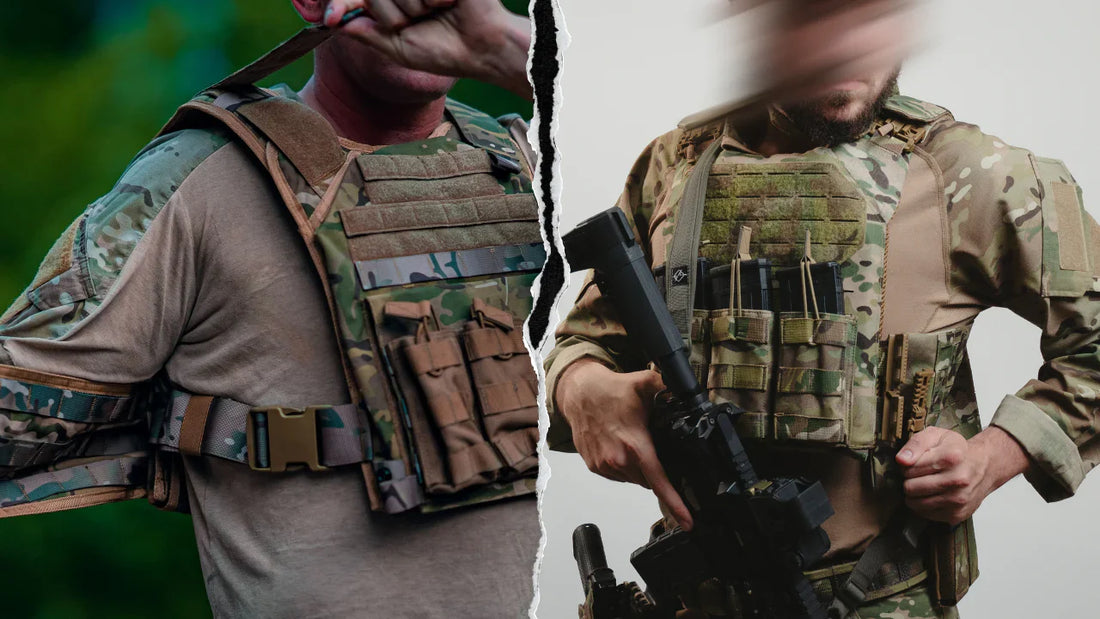Walk into any range day, training course, or SWAT briefing, and you’ll spot it right away: two distinct tribes of plate carrier enthusiasts.
On one side, the old-school MOLLE crew, rocking stitched webbing that looks like it could survive a direct hit from a belt-fed machine gun. On the other, the laser-cut MOLLE crowd, gliding around in streamlined carriers that look like they were designed by NASA.
Both are battle-proven. Both have their loyalists. But in 2025, which one’s the better choice for your loadout? Let’s break it down.
The History of MOLLE
MOLLE wasn’t the first modular gear concept, but it perfected the idea. When it replaced the old ALICE system, it revolutionized how soldiers carried their loadouts. The webbing allowed attachments to sit tight and flush against the vest or pack, preventing gear from swinging or snagging during operations.
For years, traditional MOLLE webbing dominated the field—a rugged, field-tested solution that could take years of abuse. If gear could talk, every strip of MOLLE web would have a story to tell from deployments, rescues, and training grounds.
What Is MOLLE and MOLLE Webbing?
MOLLE (Modular Lightweight Load-Carrying Equipment) is the foundation of nearly every modern tactical setup. Developed by the U.S. military in the late 1990s, the MOLLE system replaced older, fixed-load designs with a fully customizable gear platform. Instead of being locked into a single layout, operators could now configure their vests, packs, and belts to match their exact mission needs.
At the heart of this system is MOLLE webbing—the durable, evenly spaced rows of heavy-duty nylon stitched onto tactical gear. These strips act as the mounting framework that allows users to securely attach MOLLE equipment such as magazine pouches, IFAK pouches, hydration carriers, and utility bags. The design offers quick access, consistent spacing, and a secure hold, even under heavy movement or adverse conditions.
Over time, MOLLE web became the universal interface for tactical customization, trusted by soldiers, law enforcement, and civilian defenders alike. Its modular nature makes it possible to adapt your setup for any mission profile—keeping essential tools close, balanced, and ready when seconds matter.
What Is the Difference Between Traditional MOLLE Webbing and Laser-Cut MOLLE?
The main difference between traditional MOLLE webbing and laser-cut MOLLE comes down to how each system is built and how it performs in the field.
Traditional MOLLE uses thick, stitched nylon straps sewn onto gear, creating raised rows that form the attachment grid. It’s incredibly tough, easy to repair, and proven over decades of combat use.
Laser-cut MOLLE, on the other hand, removes those stitched straps entirely. Instead, it uses precision-cut slits burned directly into a single sheet of reinforced laminate or Cordura material. This eliminates extra bulk, reduces overall weight, and creates a smooth, low-profile surface that’s less likely to snag on obstacles.
Both systems are fully compatible with MOLLE pouches and attachments, but their feel and performance differ—traditional webbing delivers classic durability and field serviceability, while laser-cut designs prioritize speed, mobility, and modern efficiency.
Traditional MOLLE Webbing vs. Laser-Cut MOLLE
|
Feature |
Traditional MOLLE Webbing |
Laser-Cut MOLLE |
|
Durability |
Heavy-duty stitched nylon, decades of field use |
Extremely strong, but relies on fabric integrity |
|
Weight |
Heavier due to extra material |
Noticeably lighter |
|
Profile |
Bulkier |
Slim, low-profile |
|
Customization |
Universally compatible |
Same compatibility, but spacing may feel tighter |
|
Repairability |
Easy to re-stitch in the field |
Harder to repair if torn |
|
Look |
Rugged, classic |
Clean, modern |
Choosing the Right MOLLE Equipment for Your Mission
The real difference between laser-cut MOLLE vs. normal MOLLE depends on how you operate.
- For heavy loadouts or rough terrain: Stick with traditional MOLLE webbing. Its stitched design offers unmatched durability and field serviceability.
- For quick-response or covert operations: Go with laser-cut MOLLE. The weight savings and streamlined shape make movement easier and faster.
No matter which side you’re on, make sure your setup is mission-specific. A good MOLLE system isn’t about looks—it’s about function, access, and comfort under pressure.
Where You’ll See MOLLE at RTS Tactical
At RTS Tactical, we don’t play favorites. We use both MOLLE webbing and laser-cut MOLLE across our gear lineup—each where it performs best.
- Traditional MOLLE Webbing: You’ll find this stitched construction on our heavy-duty carriers like the RTS Tactical Premium Plate Carrier. It’s ideal for missions where durability outweighs weight savings. If you’re stacking multiple pouches, radios, or a sidearm on your vest, traditional MOLLE webbing provides the rugged reliability you can count on.
- Laser-Cut MOLLE: You’ll see this sleek style on our RTS Tactical OPSEC Plate Carrier, HST Plate Carrier, RICO Vest, Slim Tactical Vest, and Uniform Vest. These setups are engineered for mobility, speed, and a low-profile fit that still delivers elite protection.
Each system has its place—and our designs make sure you get the best of both worlds depending on your mission requirements.
Gear Up With RTS Tactical
RTS Tactical builds gear for those who stand on the front line of danger. From advanced plate carriers and body armor to ballistic shields engineered for real-world defense, every product is designed to perform when it matters most. Our equipment is tested, proven, and trusted by law enforcement, military personnel, and civilian protectors who demand strength without compromise.
When the mission calls, trust RTS Tactical to deliver elite protection for the modern hero.

